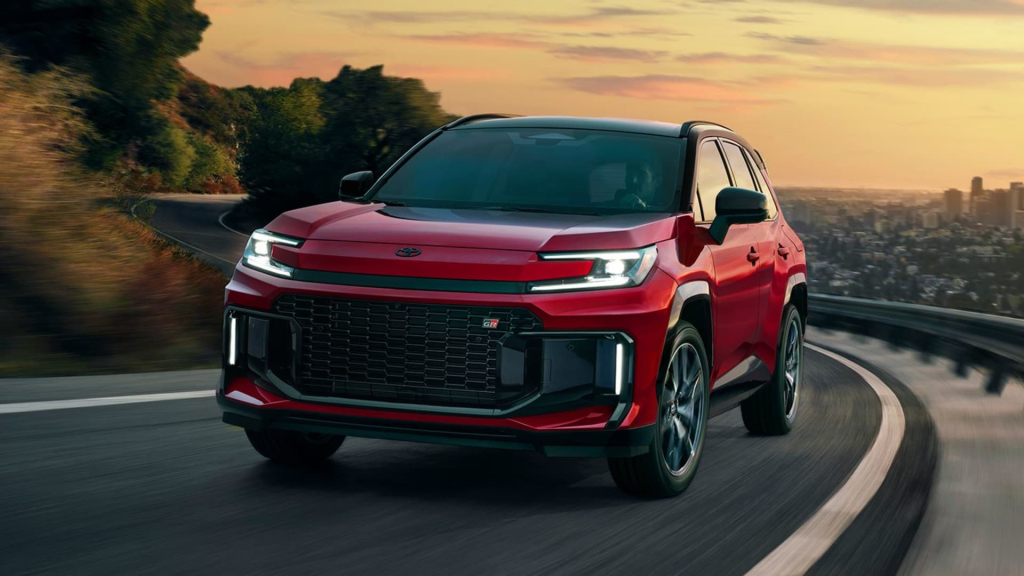PLANO, Texas — In a significant shift for its flagship model, Toyota Motor Corporation revealed on Tuesday that the RAV4, the best-selling SUV in the United States, will exclusively be available as a hybrid in its upcoming redesign.
For the first time, the 2026 Toyota RAV4 will not include a traditional gasoline engine, transitioning fully to hybrid and plug-in hybrid options. The new model will still feature a 2.5-liter four-cylinder engine but will integrate hybrid technology such as batteries and electric motors to enhance its capabilities.
As the market for all-electric vehicles grows sluggishly, automakers are increasingly turning to hybrids, which blend electric vehicle technology with conventional combustion engines. This move is seen as a way to boost vehicle performance while adhering to fuel economy regulations.
Having pioneered the hybrid market with the introduction of the Toyota Prius in the late 1990s, the company has remained a prominent proponent of hybrid technology, even as the industry pivots towards all-electric options.
In 2024, Toyota’s electrified vehicle sales in the U.S., which include hybrids, plug-in hybrids, and all-electric vehicles, constituted 43.1% of its total domestic sales of 2.3 million units.
Last year, RAV4 sales surged by 9.3%, totaling nearly 475,200 units sold, spurred by a remarkable 29.3% uptick in RAV4 hybrids and a 19.3% increase in plug-in hybrid electric vehicles. Hybrids represented roughly half of all RAV4 sales during that period.
According to data from Motor Intelligence, sales of all-electric and hybrid vehicles reached an unprecedented 20% of overall new car and truck sales in the U.S. last year, equating to around 3.2 million electrified vehicles, which include 1.9 million hybrid vehicles, both conventional and plug-in, along with 1.3 million all-electric vehicles.
Hybrid-only
David Christ, the head of the Toyota brand in North America, stated that the decision to transition the RAV4 to an all-hybrid format stemmed from its established popularity and heightened demand among consumers.
“The hybrid is faster turning; it has more sales orders on it, and the consumers and dealers are asking for it,” Christ articulated during a Finance Newso event at the automaker’s North American headquarters. “It was pretty clear that the consumer is voting for the hybrid.”
Looking ahead, Christ noted that Toyota plans to expand its hybrid portfolio, including the introduction of more plug-in hybrid electric vehicles.
With this change, RAV4 will join the ranks of seven other Toyota models that are exclusively hybrid, including the Camry, Prius, Sienna minivan, and Sequoia SUV.
Last year, hybrids made up 44% of RAV4 sales, while plug-in models accounted for 6.5%. The redesigned hybrid-only RAV4 is expected to debut in U.S. Toyota dealerships later this year, reflecting a new generation that includes both cosmetic and performance upgrades as well as advanced technology enhancements.
Although the company has yet to announce pricing details, the current RAV4 starts at approximately $30,645, with the hybrid model beginning around $33,700, inclusive of mandatory delivery fees.
Since its U.S. launch for the 1996 model year, the RAV4 has consistently seen sales growth, and last year’s sales increase of 9.3% helped it achieve the status of the best-selling non-pickup vehicle in the country.
Tariffs
However, this year presents challenges for the RAV4 due to ongoing tariffs imposed by President Donald Trump, which levy a 25% tax on imported vehicles and numerous auto parts.
While Toyota manufactures the RAV4 at its plant in Kentucky, a significant portion of U.S. sales come from models produced in Ontario, Canada. Currently, plug-in hybrid variants are exclusively imported from Japan.
Approximately half of Toyota’s U.S. sales include imported vehicles, with a notable 84.3% of RAV4 models being sourced from outside the country, alongside the popular Tacoma midsize pickup manufactured in Mexico.
Mark Templin, chief operating officer of Toyota Motor North America, indicated plans to ramp up RAV4 production in Kentucky. However, he refrained from offering specifics on modifications in production aimed at countering the impact of tariffs.
“It’ll work its way out. I think we’ll build more RAV4s in Kentucky, which will help. But that’s such a big volume car. … It was the No. 1 selling vehicle in the entire market, even beating out the F-150,” Templin remarked to Finance Newso. “Now we’re bringing out one that’s even better than that car. So, I think that we’re going to need multiple plants to build that.”
According to Cox Automotive, the RAV4 ranked third in vehicle sales last year, trailing behind the Ford F-Series and Chevrolet Silverado, which consists of several models. Yet, alternate data sources suggest that the RAV4 outperformed the Detroit trucks when analyzing individual model sales.
Toyota’s inventory supply has been one of the lowest in the automotive sector, particularly for the RAV4. Cox Automotive noted that the current supply is just 29 days, significantly below the industry average of 66 days, indicating the RAV4’s rapid turnover in the market.
Templin confirmed that the automaker is planning for various scenarios regarding tariffs and production variations, although the situation remains dynamic due to ongoing trade negotiations.
“The worst thing for an industry is uncertainty,” Templin concluded. “Consistency is the best thing we could all ask for.”


























